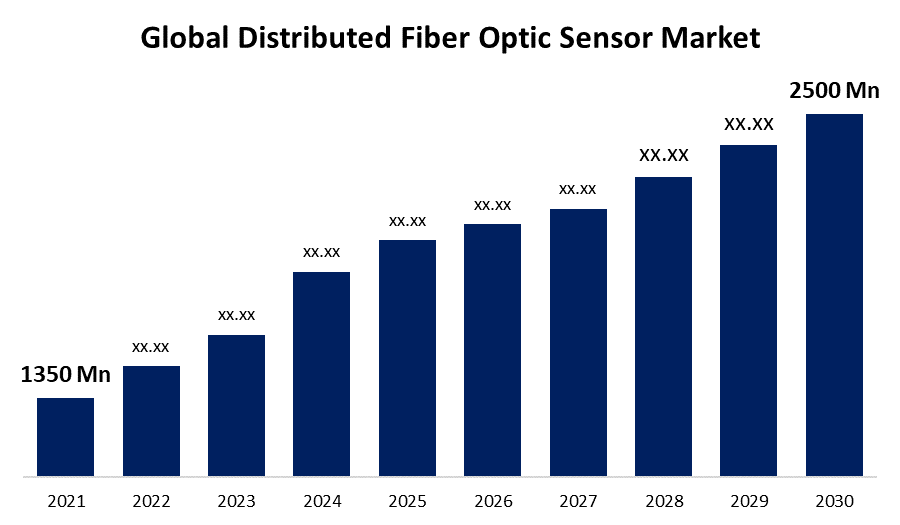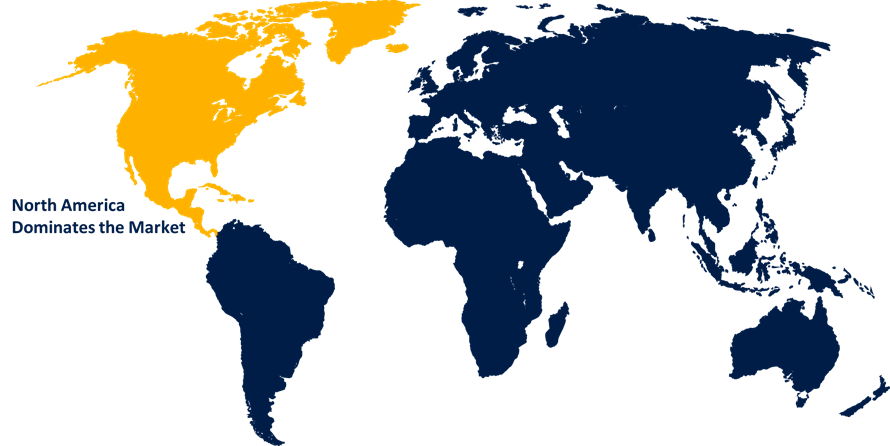Global Distributed Fiber Optic Sensor Market Size, Share, and COVID-19 Impact Analysis, By Application (Temperature Sensing, Acoustic/Vibration Sensing, Other), By Technology (Rayleigh Effect, Brillouin Scattering, Raman Effect, Interferometric, Bragg Grating), By Vertical (Oil & Gas, Power And Utility, Safety And Security), By Region (North America, Europe, Asia-Pacific, Latin America, Middle East, and Africa), Analysis and Forecast 2021 - 2030
Industry: Electronics, ICT & MediaGlobal Distributed Fiber Optic Sensor Market Insights Forecasts to 2030
- The Distributed Fiber Optic Sensor market was valued at USD 1350 million in 2021.
- The market is growing at a CAGR of 6.4% from 2022 to 2030
- The global Distributed Fiber Optic Sensor market is expected to reach USD 2500 million by 2030
- Asia Pacific is expected to grow the fastest during the forecast period

Get more details on this report -
The global Distributed Fiber Optic Sensor market is expected to reach USD 2500 million by 2030, at a CAGR of 6.4% during the forecast period 2022 to 2030. This is due to two factors: the growing demand for optic sensing, which is used extensively across a variety of industries, including the automotive, aerospace, civil, and energy sectors; and the rising offshore drilling activities combined with high investment done to discover new oil and gas reserves.
Market Overview
The market is seeing development prospects as a result of the growing demand from businesses and companies to perform efficient sensing operations on their machine systems. Optics sensing is now widely used in a variety of industries, including those related to the automotive, aerospace, civil, energy, and others. Rayleigh's effect-based and Raman effect-based sensing are two more types of sensing technologies that have unique operational properties.
Report Coverage
This research report categorizes the market for Distributed Fiber Optic Sensor market based on various segments and regions and forecasts revenue growth and analyzes trends in each submarket. The report analyses the key growth drivers, opportunities, and challenges influencing the Distributed Fiber Optic Sensor market. Recent market developments and competitive strategies such as expansion, product launch and development, partnership, merger, and acquisition have been included to draw the competitive landscape in the market. The report strategically identifies and profiles the key market players and analyses their core competencies in each sub-segments of the Distributed Fiber Optic Sensor market.
Driving Factors
The Distributed Fiber Optic Sensor (DFOS)'s functionality is enticing more businesses to invest in the technology and conduct R&D activities. This leads to the creation of new items, giving the business the chance to increase its market share. Businesses want to improve productivity and control efficiency so that fibre optics technology will prevail over all alternatives. The high cost of DFOS product deployment and installation further encourages businesses to create more dependable, competitively priced optic inspection devices. Fiber optics are characterised by technologies like optical time domain reflectometry (OTDR) and optical frequency domain reflectometry (OFDR), which perform a quality inspection of the accuracy, range, and resolution of the important market trends. Other significant technological advances include the incorporation of cutting-edge technologies like Real-Time Thermal Rating (RTTR) and intelligent Distributed Acoustic Sensor (iDAS) technologies. Increasing numbers of investments are being made in R&D projects to develop novel fibre cables that would offer fast, dependable connectivity at the lowest cost.
Global Distributed Fiber Optic Sensor Market Report Coverage
| Report Coverage | Details |
|---|---|
| Base Year: | 2021 |
| Market Size in 2021: | USD 1350 Million |
| Forecast Period: | 2021-2030 |
| Forecast Period CAGR 2021-2030 : | 6.4% |
| 2030 Value Projection: | USD 2500 Million |
| Historical Data for: | 2017-2020 |
| No. of Pages: | 202 |
| Tables, Charts & Figures: | 102 |
| Segments covered: | By Application, By Technology, By Vertical, By Region, COVID-19 Impact Analysis |
| Companies covered:: | Schlumberger Limited, OFS Fitel LLC, Halliburton Company, Yokogawa Electric Corporation, Weatherford International plc, QinetiQ Group, Luna Innovations Incorporated, Bandweaver, Omnisens SA, Brugg Kabel AG, AP Sensing GmbH, Ziebel AS |
| Pitfalls & Challenges: | Due to the increasing number of COVID-19 cases |
Get more details on this report -
Restraining Factors
The distributed fibre optic sensor business has been greatly influenced by the current worldwide pandemic, COVID-19. Several industries had to temporarily shut down operations or work with smaller teams as a result of the adoption of lockdown in various regions. Due to this, production activities and product development have decreased, which has decreased the use of fibre optics in the industrial and civil engineering sectors. The industry has prospects for expansion, nonetheless, as a result of evolving manufacturing techniques and the requirement to use fibre optics in mission-critical situations.
Market Segmentation
- In 2021, the Temperature Segment holds the largest market share over the forecast period.
On the basis of application, the global distributed fiber optic sensor market is segmented into Temperature Sensing, Acoustic/Vibration Sensing, Other. Among these, the temperature segment holds the largest market share over the forecast period. This is attributed to a variety of factors, including the rising concern for workplace safety, the dependability of DTS sensors/systems for sensing and monitoring applications in harsh environments, and the growing use of temperature sensors in the oil and gas, industrial, infrastructural, civil engineering, energy, and utility sectors.
- In 2021, the Raman Effect technology segment is dominating the market over the forecast period.
Based on technology, the global distributed fiber optic sensor market is segmented into Rayleigh Effect, Brillouin Scattering, Raman Effect, Interferometric, Bragg Grating. Among these, Raman Effect technology segment is dominating the market over the forecast period. This can be attributed to the employment of technology in crucial circumstances like the security of huge structures, the identification of coolant leaks, and the detection of fires with the use of sophisticated data processing techniques. Additionally, the technology's resistance to electromagnetic interference enables continuous monitoring and the avoidance of structural issues in complex infrastructures like bridges and rail tracks. Additional technologies like as Bragg grating, Raman Effect, interferometric, and Brillouin scattering have a large market influence.
- In 2021, the Oil and Gas segment is dominating the market with the largest market share.
On the basis of vertical, the global distributed fiber optic sensor market is segmented into Oil & Gas, Power And Utility, Safety And Security. Among these, the oil and gas segment is dominating the market with the largest market share over the forecast period. For improved performance and real-time, precise downhole monitoring, which results in data-driven decision-making, DFOS is crucial. In addition to providing a boost to industry growth, the use of fibre optics for Distributed Temperature Sensing (DTS) and Distributed Acoustic Sensing (DAS) helps address common problems encountered in oil and gas fields every day.
Regional Segment Analysis of the Distributed Fiber Optic Sensor Market

Get more details on this report -
- North America (U.S., Canada, Mexico)
- Europe (Germany, France, U.K., Italy, Spain, Rest of Europe)
- Asia-Pacific (China, Japan, India, Rest of APAC)
- South America (Brazil and the Rest of South America)
- The Middle East and Africa (UAE, South Africa, Rest of MEA)
North America dominates the market with the largest market share of 40% over the forecast period.
With a 40% market share in 2021, North America dominated the market. This is because the U.S. has a sizable oil and natural gas industry, which encourages higher adoption rates for dispersed fibre optic cables. Hydraulic fracturing and horizontal drilling, both of which make use of high-performance optical fibres, helped the U.S. produce roughly 33.4 trillion cubic feet of natural gas in 2020. In order to increase their capacity for profit generation, oil and gas firms are encouraged by the rising price of crude oil to implement more accessible and effective support systems. This expands the market for distributed fibre optic sensors' potential for growth.
Recent Developments
- In July 2020, Odassea, a distributed acoustic sensing solution for subsea wells created by Halliburton and TechnipFMC, enables operators to take part in intervention-free reservoir diagnostics seismic imaging to enhance reservoir understanding and lower total cost of ownership.
Competitive Analysis:
The report offers the appropriate analysis of the key organizations/companies involved within the global Distributed Fiber Optic Sensor market along with a comparative evaluation primarily based on their product offering, business overviews, geographic presence, enterprise strategies, segment market share, and SWOT analysis. The report also provides an elaborative analysis focusing on the current news and developments of the companies, which includes product development, innovations, joint ventures, partnerships, mergers & acquisitions, strategic alliances, and others. This allows for the evaluation of the overall competition within the market.
List of Key Companies
- Schlumberger Limited
- Halliburton Company
- Yokogawa Electric Corporation
- Weatherford International plc
- QinetiQ Group
- Luna Innovations Incorporated
- OFS Fitel LLC
- Bandweaver
- Omnisens SA
- Brugg Kabel AG
- AP Sensing GmbH
- Ziebel AS
Key Target Audience
- Market Players
- Investors
- End-users
- Government Authorities
- Consulting And Research Firm
- Venture capitalists
- Value-Added Resellers (VARs)
Market Segment
This study forecasts revenue at global, regional, and country levels from 2019 to 2030. Spherical Insights has segmented the global Distributed Fiber Optic Sensor market based on the below-mentioned segments:
Distributed Fiber Optic Sensor Market, By Application
- Temperature Sensing
- Acoustic/Vibration Sensing
- Other
Distributed Fiber Optic Sensor Market, By Technology
- Rayleigh Effect
- Brillouin Scattering
- Raman Effect
- Interferometric
- Bragg Grating
Distributed Fiber Optic Sensor Market, By Vertical
- Oil & Gas
- Power And Utility
- Safety And Security
Distributed Fiber Optic Sensor Market, Regional Analysis
- North America
- US
- Canada
- Mexico
- Europe
- Germany
- Uk
- France
- Italy
- Spain
- Russia
- Rest of Europe
- Asia Pacific
- China
- Japan
- India
- South Korea
- Australia
- Rest of Asia Pacific
- South America
- Brazil
- Argentina
- Rest of South America
- Middle East & Africa
- UAE
- Saudi Arabia
- Qatar
- South Africa
- Rest of Middle East & Africa
Need help to buy this report?